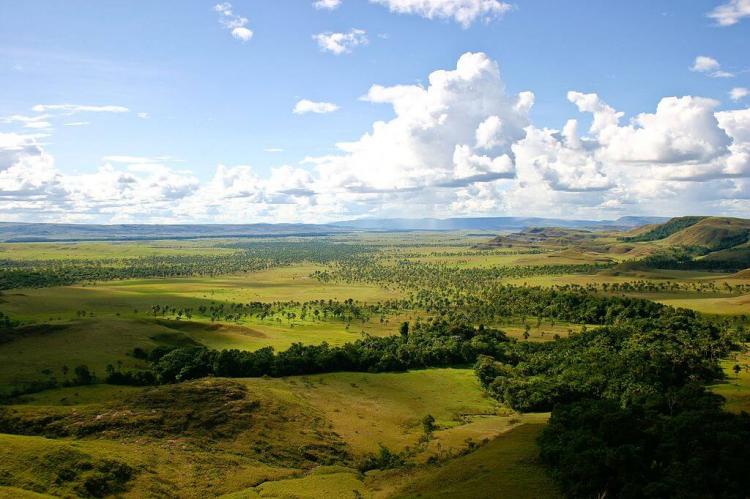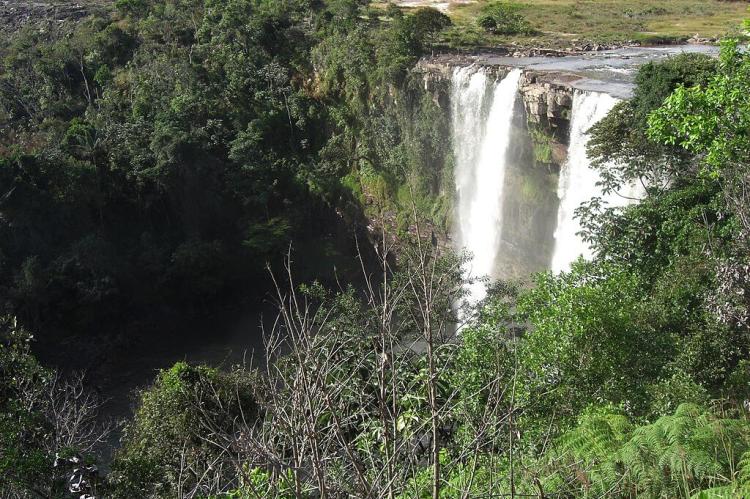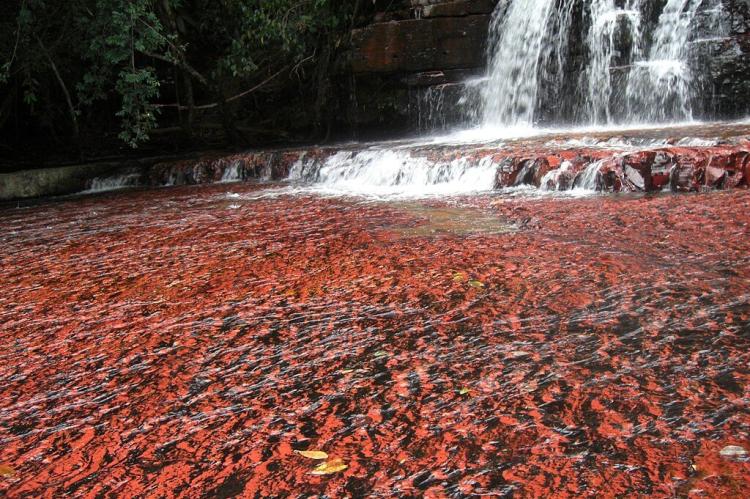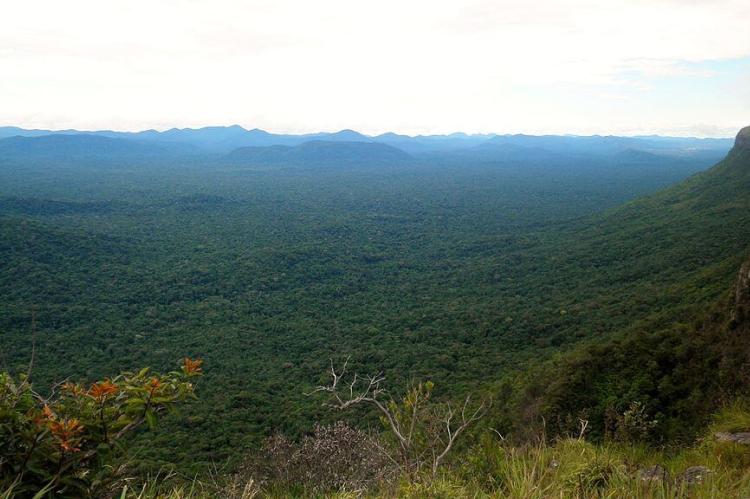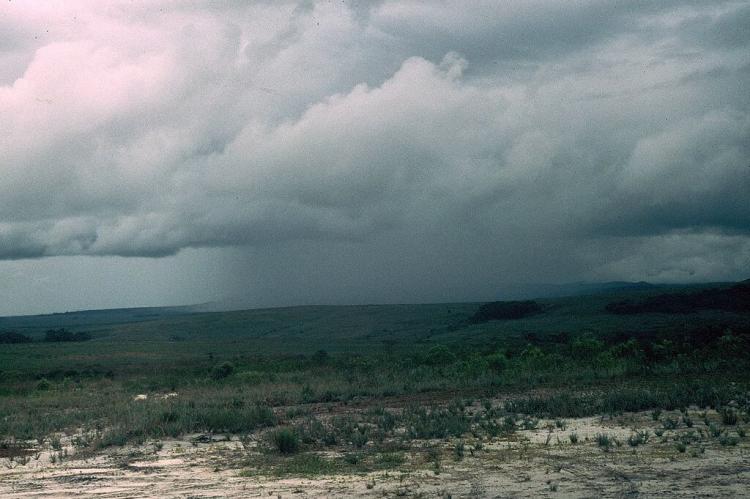Islands in the Sky: Venezuela's Gran Sabana
La Gran Sabana is a vast plateau in southeastern Venezuela within Canaima National Park, part of the Guiana Shield. It features spectacular tepuis—isolated tabletop mountains with sheer cliffs above savannas—and hosts over 4,800 plant species, including many endemic and carnivorous plants.
La Gran Sabana: Venezuela's Ancient Plateau of Biodiversity and Geological Wonder
Geography and Location
Situated in southeastern Venezuela within Bolívar State, La Gran Sabana emerges as one of South America's most extraordinary natural regions. This vast elevated plateau encompasses approximately 10,820 square kilometers (4,180 square miles) and forms an integral component of Canaima National Park, Venezuela's second-largest protected area. The region extends from the Guiana Highlands to the international borders with Brazil and Guyana, lying between latitudes 4°45′ and 5°30′N and longitudes 60°30′ and 61°22′W ′ W. At elevations ranging from 800 to 1,500 meters (2,625 to 4,921 feet) above sea level, La Gran Sabana represents a distinctive segment of the Guianan Savanna ecoregion, one of the most biodiverse and geologically ancient landscapes on Earth.
Geological Heritage: Windows into Deep Time
La Gran Sabana's geological narrative spans an almost incomprehensible timeframe, reaching back approximately 1.8 to 2 billion years to the Precambrian era. The region sits atop the Guiana Shield, one of Earth's ancient cratons composed of Proterozoic rock formations. The dominant geological feature consists of the Roraima Supergroup—massive formations of quartz arenite sandstone and quartzite that accumulated as sedimentary deposits during the Precambrian, subsequently compressed and metamorphosed into extraordinarily resistant rock.
These ancient sandstone formations once comprised a vast, continuous plateau. Beginning approximately 300 million years ago, erosion—driven by water, wind, and chemical weathering—began sculpting this massive plateau. Over tens of millions of years, softer surrounding materials eroded away, leaving behind only the most resistant quartzite structures. The fragmentation accelerated during the breakup of Gondwana, when South America separated from Africa roughly 150 million years ago. By approximately 70 million years ago, the isolated tabletop mountains known as tepuis had achieved their characteristic form as erosional remnants—geological monuments standing as testament to the region's extraordinary antiquity.
The soils throughout La Gran Sabana reflect this ancient geological substrate. Shallow and nutrient-poor, typically less than 20 to 30 centimeters (8 to 12 inches) in depth, these soils develop from the weathering of quartzitic sandstone. The high sand content, extremely acidic pH, and low nutrient availability create challenging conditions for plant growth, yet paradoxically support remarkable botanical diversity.
The Tepuis: Islands in the Sky
The defining geological features of La Gran Sabana are its tepuis—from the Pemon word meaning "house of the gods"—isolated tabletop mountains rising dramatically from the surrounding savanna. These extraordinary formations, characterized by near-vertical cliffs reaching 400 to 1,000 meters (1,312 to 3,281 feet) in height and remarkably flat summit plateaus, create some of Earth's most distinctive landscapes. Each tepui functions as an ecological island, harboring unique assemblages of endemic species that evolved in isolation over millions of years.
Mount Roraima, the most celebrated of these formations, stands at 2,810 meters (9,219 feet) at its highest point, making it the tallest tepui globally. Straddling the tripoint border of Venezuela, Brazil, and Guyana, Roraima's summit plateau encompasses approximately 31 square kilometers (12 square miles). The mountain's surface presents an otherworldly landscape of pseudokarst formations—features resembling traditional limestone karst but formed through silica dissolution. This process creates labyrinthine valleys, deep sinkholes, and crystal-clear pools known locally as "jacuzzis."
Other significant tepuis include Auyán-tepui, covering 700 square kilometers (270 square miles) and home to Angel Falls, Earth's highest uninterrupted waterfall, with a total height of 979 meters (3,212 feet). These geological giants continue to shape the hydrology of La Gran Sabana, as precipitation falling on their summits feeds numerous rivers and creates spectacular waterfalls cascading from their cliff edges.
Climate and Ecosystems
La Gran Sabana experiences a tropical highland climate moderated by elevation. The region records mean annual temperatures around 20°C (68°F), with notable diurnal fluctuations. Daytime temperatures typically range from 20 to 25°C (68 to 77°F), while nighttime temperatures commonly drop to 13°C (55°F) or lower. The tepui summits experience nearly constant precipitation and cloud cover, creating permanently humid microclimates that support unique vegetation types, including cloud forests, shrublands, and herbaceous communities.
The region encompasses a remarkable mosaic of ecosystems. Extensive grasslands dominate the landscape, with research indicating that many Gran Sabana savannas originated through repeated burning, transforming once-forested landscapes into open grasslands. These savannas support diverse communities dominated by grasses (Poaceae), sedges (Cyperaceae), asters (Asteraceae), and melastomes (Melastomataceae). Along watercourses, gallery forests create ribbons of lush vegetation, supporting diverse tree species, lianas, epiphytes, and the iconic Mauritia flexuosa (moriche palm).
The tepui summit plateaus host some of Earth's most unusual plant communities. The combination of extreme conditions—near-constant cloud cover, intense solar radiation, nutrient-depleted substrates, and high precipitation—has driven the evolution of highly specialized flora with extraordinary endemism. Endemic plant genera include Achnopogon, Chimanta, Quelchia, Tepuia, and numerous others found nowhere else on Earth.
Perhaps most remarkable are the carnivorous plant communities. The genera Heliamphora (sun pitchers), Drosera (sundews), and Utricularia (bladderworts) have evolved insectivorous habits to supplement photosynthesis in the severely nutrient-limited environment. These plants trap and digest small insects, obtaining nitrogen and other essential nutrients unavailable from the impoverished substrate. The genus Heliamphora, entirely endemic to the Guiana Highlands tepuis, represents one of the world's most primitive carnivorous plant lineages.
Biodiversity and Endemism
La Gran Sabana harbors exceptional biological diversity, with remarkably high levels of endemism reflecting both the region's ancient geological history and the extreme isolation of tepui summits. Scientific surveys have documented over 4,800 plant species in the broader region, with approximately 260 endemic species recorded specifically within the Gran Sabana portion. According to the Catalog of the Vascular Flora of Venezuela, 451 plant species in the area are endemic, representing a significant portion of the national endemic flora.
The mammalian community includes apex predators such as Panthera onca (jaguar) and Puma concolor (puma), which play crucial roles in regulating prey populations. Other notable species include Hydrochoerus hydrochaeris (capybara)—the world's largest rodent—the endangered Priodontes maximus (giant armadillo), Myrmecophaga tridactyla (giant anteater), and several primate species, including Alouatta seniculus (Venezuelan red howler monkey). The tepui summits support endemic small mammals, including Podoxymys roraimae (Roraima mouse), found only in these isolated highland habitats.
The avifauna exemplifies the high endemism characterizing tepui ecosystems. Endemic species include Streptoprocne phelpsi (tepui swift), Polytmus milleri (tepui goldenthroat), and Troglodytes rufulus (tepui wren). The critically endangered Cercomacra carbonaria (Rio Branco antbird) serves as an indicator species for ecosystem health. Other notable species include the spectacular Rupicola rupicola (Guianan cock-of-the-rock) and the powerful Harpia harpyja (harpy eagle).
The amphibian and reptile communities exhibit remarkable diversity and endemism. Several frog species occur exclusively within Gran Sabana, including Anomaloglossus parkerae, Stefania scalae, and Tepuihyla rodriguezi. The vulnerable Oreophrynella quelchii (Roraima bush toad), found solely on tepui summits, exhibits an unusual defense behavior: it rolls off rocks rather than jumping when threatened.
Indigenous Heritage: The Pemon People
The Pemon people have inhabited the Gran Sabana region for millennia, developing profound cultural and spiritual connections with the landscape. As the traditional custodians of these lands, the Pemon maintain intricate knowledge systems regarding the region's ecology, seasonal patterns, and sustainable resource use.
In Pemon cosmology, the tepuis hold sacred status as dwelling places of mawari (spirits) and repositories of supernatural power. Mount Roraima occupies a central position in Pemon mythology as the stump of a mighty tree that once bore all the world's fruits and vegetables. According to legend, the culture hero Makunaima felled this cosmic tree, causing a catastrophic flood that reshaped the landscape. The plateau represents the tree's remaining stump, forever marking this primordial event.
Pemon traditional knowledge encompasses a detailed understanding of plant properties, animal behavior, weather patterns, and landscape dynamics. This knowledge informs subsistence practices, including hunting, fishing, gathering, and small-scale agriculture, adapted to the challenging environment. Contemporary Pemon communities actively participate in tourism operations, serving as guides and cultural interpreters for visitors, providing economic opportunities while maintaining connections with ancestral territories.
Exploration and Scientific Discovery
La Gran Sabana entered European consciousness during the colonial era as Spanish and Portuguese expeditions penetrated the interior of the Guiana Highlands. Systematic scientific exploration accelerated during the nineteenth century. The pioneering work of botanists and naturalists, including Robert Schomburgk's 1835 expedition to Mount Roraima, inspired Sir Arthur Conan Doyle's 1912 novel The Lost World.
In December 1884, Sir Everard Im Thurn led the first confirmed ascent of Mount Roraima, discovering a forested ramp on the Venezuelan side that remains the standard non-technical route. Twentieth-century research expanded dramatically, with expeditions documenting that 40% of Venezuela's plant species and 23% of its reptiles and amphibians occur in Gran Sabana, underscoring the region's conservation significance.
Conservation Challenges and Strategies
Despite its protected status within Canaima National Park—established in 1962 and encompassing approximately 3 million hectares (7.4 million acres)—La Gran Sabana faces multiple conservation threats.
Anthropogenic fires represent the most pervasive threat. The region experiences extremely high fire frequency, with many areas burning annually or biannually. While Indigenous peoples have used fire as a land management tool for millennia, the contemporary fire regime appears unsustainable. Repeated burning prevents forest regeneration, leading to progressive "savannization" as forests transform irreversibly into grasslands.
Illegal gold and diamond mining operations persist throughout the region, causing mercury pollution, dramatically increased sediment loads in rivers, deforestation, and wildlife disturbance. The growing tourism industry, while providing economic benefits, creates environmental pressures including littering, illegal collection of species, and trail erosion. Climate change may alter the delicate ecological balance of tepui summit communities, threatening endemic species with narrow environmental tolerances.
Effective conservation requires integrated approaches addressing multiple threats while respecting Indigenous rights. Canaima National Park's UNESCO World Heritage designation (1994) recognizes the region's outstanding universal value. Conservation priorities include developing culturally appropriate fire management strategies, promoting responsible tourism practices with indigenous-led guiding, supporting research and long-term ecological monitoring, and ensuring Pemon participation in decision-making processes.
Visiting La Gran Sabana
For travelers, La Gran Sabana offers unparalleled opportunities to experience one of Earth's most extraordinary landscapes. Santa Elena de Uairén, the region's largest town with over 30,000 inhabitants and located just 15 kilometers (9.3 miles) from the Brazilian border, serves as the primary gateway.
Multi-day treks to Mount Roraima, typically lasting 6 days, offer the quintessential Gran Sabana experience. The standard route follows Im Thurn's 1884 path, ascending through savanna grasslands, crossing rivers and waterfalls, and finally reaching the otherworldly summit plateau. Tours organized through reputable operators employ Pemon guides and porters, supporting local economies while ensuring visitor safety and minimizing environmental impacts.
The region's numerous waterfalls, including the spectacular Quebrada de Jaspe (Jasper Creek)—where the streambed consists of red jasper—provide additional attractions accessible along the Gran Sabana highway. Visitors should recognize their privilege in experiencing this ancient landscape and their responsibility to protect it for future generations.
